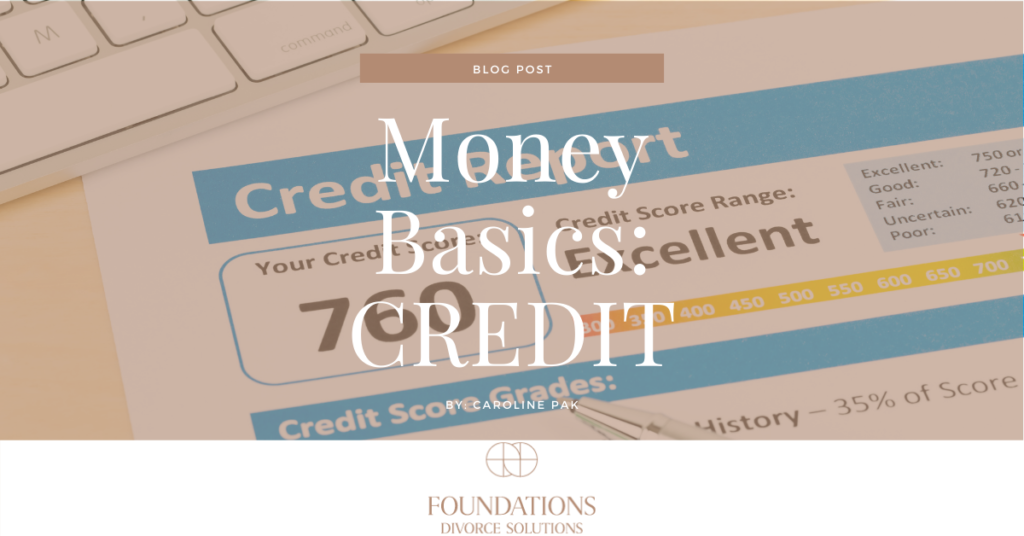As we continue our Money Basics Series on Build Your Foundations, we have so far touched on the ABC’s of basic budgeting, setting financial goals, and eliminating debt. This week, we will focus on credit.
A friend from Australia was sharing that when she came to the United States as a student, no one spoke to her about money basics and establishing credit. Credit is tricky and building good credit is definitely a long game. She recently had the rude awakening that she should have started trying to build her credit when she first arrived in the US instead of years later when she finally had a need for the credit.
For those of us who grew up in the States, we may have started our credit journey with a small credit card when we entered college, got our first car loan with a co-signer or our local bank offered us a credit card or loan because we did our banking there and were good at handling our checking and savings accounts. Some of us have never had this opportunity and some of us may need to start the credit journey on our own.
In our last article, we reviewed how to eliminate debt. Debt is essentially money you owe to creditors. Some types of credit may be in the form of a credit card, car loan, line of credit, or mortgage. How someone builds credit is by borrowing from a lender and paying them back, on time, and for the amount which you agreed to pay either in your loan agreement or in the credit card application. Let’s go over some of the different types of credits available to us.
CREDIT CARD
Who hasn’t seen an ad for Visa, Mastercard, or American Express or for a credit card to your favorite store, favorite bank, or favorite airline? Basically, a bank, with their own branding or a partnership with your favorite store or airline agree to give you credit of a set amount in return for you to use this credit and make a payment for the credit used every month, and not to go over the credit limit you have been granted. If you are consistent at paying your payments on time and stay within your credit limit, the bank will most likely be willing to give you a larger credit line with some time.
If you are just starting your credit journey, you may have to request a secured credit card through your bank. Essentially, you are setting aside an amount of cash for your bank to use as collateral for the credit card. Many secured cards start with a $500 limit and are secured for a year. After one year, if you have shown your bank that you are able to use the credit card responsibly, they will give you back the cash you put up to start the credit card and convert your secured card into an unsecured card. This may be your very first step to building a credit foundation and your credit history.
PERSONAL LOAN
Personal loans can come in the form of a collateralized loan such as a car loan (or if you are in the market, a boat or RV), a home mortgage, or an uncollateralized loan. A collateralized loan rate may be lower and the amount of the loan granted may be higher because there is something that the banks will hold as something they can take back as payment if the loan is forfeited (same with the secure credit card mentioned above). With an uncollateralized loan, if the person taking the loan decides to stop their loan payments, the bank is out of luck and out of the money they put up for you to spend so they limit their risk and keep the loan amounts a little lower and the rates a bit higher than the collateralized loans. If you are starting to establish your credit foundation and history, you may need to have a co-borrower otherwise known as a co-signer, who already has an established credit history in order for you to piggyback off of their history.
LINE OF CREDIT
Lines of credit may also be a personal line of credit which is uncollateralized or a line of credit secured against a home or even your investment account. Again, the unsecured line of credit limit may be much smaller than the collateralized line of credit but take note that on the secured line of credit, especially one that is collateralized against your investment account, there may be a margin call, where the stocks you have collateralized has fallen in value and no longer worth as much as you have taken out in credit and your lender wants you to pay back the difference. On a home equity line of credit, if your house falls below the appraised value and you have extended credit against the line of credit and you are unable to pay back the difference, you are now upside down, which is not an ideal financial situation to be in.
CREDIT SCORE
Have you ever heard the saying “Bad credit is better than no credit”? Now that we have reviewed the different types of credit available, let’s talk about how to build your credit. When one has bad credit, it means that there is a history of negative activity on your credit report which has been started versus no credit means there is no history of whether you know how to borrow and pay back lenders. So how do you build credit history? One way is by establishing at least one credit account which has been open for at least 6 months or longer and have this account be reported to the credit bureaus within the following six months. And it goes without saying, making payments on time and not going over your credit limit.
When someone asks you about your credit score, they are essentially asking what your FICO is. FICO stands for the Fair, Isaac, and Company, who originally created a rating system of 300 being poor to 850 being excellent to measure consumer credit risk. Risk meaning whether someone is going to pay back the money they borrowed from a lender. The three best-known credit bureaus are Experian, Equifax, and TransUnion. Equifax and Experian consider a score under 580 as very poor and the average credit score in the US is somewhere in the mid 700’s. In Washington State, the average FICO in 2020 was 730, up 7 points from the year before. FICO has a magic formula of how much credit to utilize on your credit card and line of credit to get an 850 on your credit score. Back in 2019, it was said that 1.2% of Americans held the coveted 850 FICO.
As you start to build your credit foundation, for every credit account you open, this creates a history of how you manage your money and how you manage your debts. For every loan you pay on time and in full, this creates a history that you are a reliable borrower, you know when your payment is due and you pay them on time. For every credit card you open, borrow against, make payments on and keep within the credit limit, this also builds your history.
To wrap things up, how do you build good credit? Start with building your credit history – at least one account that has been opened for 6 months, and reported to the credit bureaus such as Equifax, Experian, and TransUnion for the recent 6 months. Show that you pay your payments on time – pay your credit card bill in full or at least the minimum due before the due date. DO NOT GO OVER YOUR CREDIT LIMIT! And another secret, keep the very first major credit card you ever opened, open, even if you do not use it any longer. This is the very beginning of your credit history, the first piece in your credit foundation. You don’t want to wipe away any history you may have established, especially if you didn’t open another credit card for another few years. You worked hard to start this foundational piece, to build the history, there’s no need to wipe it clear and have a new starting point.
At Build Your Foundations, we are here to help you put together a budget, set financial goals, help you work towards getting out of debt, and even help you on your journey to build your credit history. The examples provided are generalized and are not customized to your specific credit journey. We would love to meet with you to help you customize your money basics with a free consultation.




